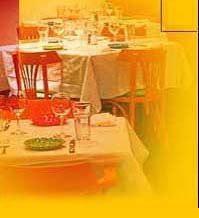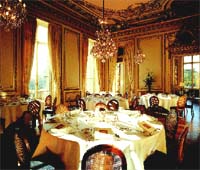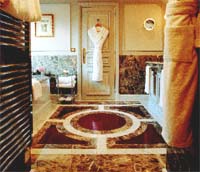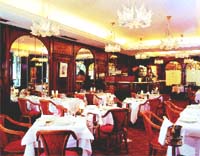



 The Crillon Experience
The Crillon Experience
CHANDLER BURR, the UpperCrust's New York-based food and travel writer, visits Paris' Crillon Hotel, a 5-star palace of luxury and a temple of French cuisine. |
|
There are hotels, and then there are mythic hotels. I ride my bright red scooter through Paris, down the Champs Elysees, past the Rond Point just beside the Seine. I buzz past the Tuileries Gardens (the Louvre in the background), glimpse the majestic Madeleine, and head in the direction of the flag in front of the American Embassy. I park in front of a palace built when Louis XV commissioned architect Jacques-Ange Gabriel in 1758 to create one of the most magnificent facades in Paris and bought in 1788 by the Count de Crillon. This is the Crillon Hotel, a 5-star palace of luxury and a temple of French cuisine. And when you're staying in a hotel that you enter by walking in off the Place de la Concorde, that is a mythic hotel.
The thing about Jean-François Piège is that he originally wanted to be a gardener. He's from the Drôme region of south-eastern France, known for the quality of its fresh produce, "And as a child," says Piège, age 34, "I would help my great uncle do the gardening. I loved having that kind of relation to food: being able to say, 'I grew it, and now I'm eating it!'" He's had the typically peripatetic career of the professional chef, ranging from time at a ski resort to a stint in the kitchens of the French presidential palace, a (previous) position at the Hotel Crillon under Christian Constant, learning the art and technique of hotel cuisine, and then Monte Carlo, under Alain Ducasse.
From my table I can see the traffic on the Place de la Concorde, plus any number of well-dressed Parisians and their foreign lunch companions. We get down to business. I'm not ordering; I'm letting Piège send me his creations as he sees fit. We start with Osetra Caviar and Langoustines (which, I should mention, is 100 Euros). It is served on a liquid white sauce that contains the fragrance of the ocean, yet that fragrance is muted; this is not strong seafood but rather a delicately light dish that uses seafood ingredients. Next is a creation made of the flesh of "sea spider," a large crab-like crustacean, in a frothly emulsion of Manni olive oil. The froth is amazing, as if the crab had suddenly exploded and generated this foam. He finishes this dish off with a lemon basil sauce that gives a tang to the crab taste.
When after lunch Piège sits down at my table and talks with me about his cuisine, he proves to be a very practical guy. His approach is simple: Use the full flavour of the raw materials, and if you can, make sure that the diner's memories will be triggered, making the dish richer and more layered. He's very precise: "Sometimes you cook at high heat, sometimes at low, simply depending on the flavour you want to create in the products," he says. He uses only the best products; that Manni olive oil is one of the most expensive in the world; Piège has one of the waiters brings some out, pours a small amount on a plate, and has me taste. It tastes as smooth as velvet. He's quite happy to be here at the Crillon, he says, a place where a French chef can truly exercise his culinary arts to the fullest degree. Although, he admits, the job keeps him rather busy. And then he's gone, back to the kitchen to prep for dinner. The Crillon
|

Home Page
About the mag
Subscribe
Advertise
Contact Us
 I'm
here for a meal in the restaurant Les Ambassadeurs, and to
get the full feel of the Crillon experience I'm staying the
night. Which means the first Crillon experience, checking
in at a Louis XV desk (with a 2004 computer on it) and then
being escorted to a room in which one could comfortably land
a small plane. During check-in, I meet an exquisitely lovely
German woman dressed entirely in Chanel, blond hair perfectly
coifed. This is Franka Holtmann, the hotel's general manager.
On the job since September 2003 (after five years at the Ritz
in Paris), Franka is actually the first female GM of a 5-star
hotel in history. It's quite a job; the luxury hotel sector
in Paris is intensely competitive, and yet she manages this
masterfully. We discuss Chef Jean-François Piège , to whom
Franka has decided to entrust the hotel's gastronomic restaurant
and whose cuisine I will try later.
I'm
here for a meal in the restaurant Les Ambassadeurs, and to
get the full feel of the Crillon experience I'm staying the
night. Which means the first Crillon experience, checking
in at a Louis XV desk (with a 2004 computer on it) and then
being escorted to a room in which one could comfortably land
a small plane. During check-in, I meet an exquisitely lovely
German woman dressed entirely in Chanel, blond hair perfectly
coifed. This is Franka Holtmann, the hotel's general manager.
On the job since September 2003 (after five years at the Ritz
in Paris), Franka is actually the first female GM of a 5-star
hotel in history. It's quite a job; the luxury hotel sector
in Paris is intensely competitive, and yet she manages this
masterfully. We discuss Chef Jean-François Piège , to whom
Franka has decided to entrust the hotel's gastronomic restaurant
and whose cuisine I will try later.  Now, he's back at the Crillon as a major player in Paris.
Travel & Leisure magazine recently wrote, "Paris hotels
are hitching themselves to celebrity chefs faster than the
guides can deal out stars," and they've put Piège name
on the front of the menu and he's fortunate to have a completely
redesigned stage in which to work. As I enter via the Winter
Garden Tea Room with its garden-like feel and take my seat,
I can see the vast change that has been made here. This room
is not all that large, but it has a hugely spacious feel given
its vast ceiling height, and gone now are the heavy dark blue
curtains that used to cover its tall windows. You'll never
be able to change the fact that the decor will always be ornate
(it has, someone said, more marble and gilt cherubs than a
cathedral). But actually the Baroque atmosphere is fun, and
the champagne-coloured curtains lighten everything, with beige
lamp shades that reflect the lighter colors of the marbles.
Now, he's back at the Crillon as a major player in Paris.
Travel & Leisure magazine recently wrote, "Paris hotels
are hitching themselves to celebrity chefs faster than the
guides can deal out stars," and they've put Piège name
on the front of the menu and he's fortunate to have a completely
redesigned stage in which to work. As I enter via the Winter
Garden Tea Room with its garden-like feel and take my seat,
I can see the vast change that has been made here. This room
is not all that large, but it has a hugely spacious feel given
its vast ceiling height, and gone now are the heavy dark blue
curtains that used to cover its tall windows. You'll never
be able to change the fact that the decor will always be ornate
(it has, someone said, more marble and gilt cherubs than a
cathedral). But actually the Baroque atmosphere is fun, and
the champagne-coloured curtains lighten everything, with beige
lamp shades that reflect the lighter colors of the marbles.
 Our
third course is called in French Blanc 'Manger D'oeuf, and
it is, honestly, a little strange. Essentially this is a very
light, whipped mousse of egg as light as a cloud. Piège
puts in girolles, very expensive mushrooms, and uses a ciboulette
oil to finish, and the result is like eating, well, cloud.
An odd sensation. But then he changes gears and sends out
an Homard Bleu, a blue lobster, on Spaghetti Carbonara (again,
note that this dish costs 95 Euros). Blue lobsters come from
Brittany, and the delicate taste is terrific with the Italian-style
pasta, which is tumbled together in the various tastes of
the light carbonara sauce. The last dish is a young lamb from
the Limousin region of France, with herbs, eggplant, and parmesan
cheese. The meat course: it is always surprising how much
richer than seafood red meat is, and this is no exception,
the herbs and cheese bringing out a heavier, more filling
feeling to this dish. The herbs are quintessentially French;
you can taste the mountains and the air, and it's a mixture
that isn't Italian.
Our
third course is called in French Blanc 'Manger D'oeuf, and
it is, honestly, a little strange. Essentially this is a very
light, whipped mousse of egg as light as a cloud. Piège
puts in girolles, very expensive mushrooms, and uses a ciboulette
oil to finish, and the result is like eating, well, cloud.
An odd sensation. But then he changes gears and sends out
an Homard Bleu, a blue lobster, on Spaghetti Carbonara (again,
note that this dish costs 95 Euros). Blue lobsters come from
Brittany, and the delicate taste is terrific with the Italian-style
pasta, which is tumbled together in the various tastes of
the light carbonara sauce. The last dish is a young lamb from
the Limousin region of France, with herbs, eggplant, and parmesan
cheese. The meat course: it is always surprising how much
richer than seafood red meat is, and this is no exception,
the herbs and cheese bringing out a heavier, more filling
feeling to this dish. The herbs are quintessentially French;
you can taste the mountains and the air, and it's a mixture
that isn't Italian.  I almost can't lift a fork at this point, but then he sends
out the dessert. This, I must admit as I taste it, is perhaps
my favorite part of the whole meal, a cluster of wild strawberries
hidden under a cloud of cotton candy. The strawberries are
sweet and tangy and fruity, the cotton candy even sweeter
and melting in the mouth.
I almost can't lift a fork at this point, but then he sends
out the dessert. This, I must admit as I taste it, is perhaps
my favorite part of the whole meal, a cluster of wild strawberries
hidden under a cloud of cotton candy. The strawberries are
sweet and tangy and fruity, the cotton candy even sweeter
and melting in the mouth.